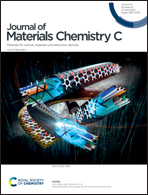Chemical sensors based on ionically conductive metal–organic frameworks for selective cadaverine detection†
Abstract
Based on ionically conductive metal–organic frameworks (IC-MOFs), sensing materials with metal ions rather than electrons as charge carriers were developed. Chemical sensors were then developed to detect cadaverine (Cad) vapors, which have been considered as an important chemical marker of food spoilage and are closely related to medical health. A series of IC-MOFs were fabricated and compared using different types of metal ions (Cu2+, Co2+, Ni2+, Zn2+, and Mg2+). The sensors exhibited distinct responses to Cad, while the sensors based on IC-CuTHPP-MOFs showed the greatest response among all sensors for the detection of Cad. The estimated detection limit of the sensor was 4.9 nL. These sensors showed high sensitivity and selectivity to Cad vapor with an irreversible response; however, the response to common volatile organic compounds (VOCs) was almost completely reversible. The sensors demonstrated short response time, good device uniformity, and long-term stability. As a demonstration, the sensor provided a fast and real-time response to rotting meat in a few seconds. IC-MOF-based sensors have great potential to promote food safety and safeguard human health.



 Please wait while we load your content...
Please wait while we load your content...